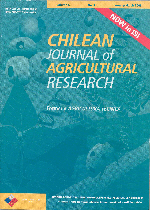
|
Agricultura Técnica
Instituto de Investigaciones Agropecuarias, INIA
ISSN: 0365-2807
EISSN: 0365-2807
Vol. 61, No. 4, 2001, pp. 522-526
|
 Bioline Code: at01055
Bioline Code: at01055
Full paper language: Spanish
Document type: Research Article
Document available free of charge
|
|
|
Agricultura Técnica, Vol. 61, No. 4, 2001, pp. 522-526
| en |
Defoliation Effect on Three Phenological Stages upon Tomato (Lycopersicon EsculentumMill.) Yield under Greenhouse
Martínez, Susana; Grimaldi, María Cecilia; Garbi, Mariana & Artur, Miguel
Abstract
A tomato (
Lycopersicon esculentum
Mill.) crop was grown under greenhouse in La Plata, Argentina (34º58'S
lat, 57º54'W long) with the aim of studying the effect on the
yield of the elimination of the third leaf between trusses in three phenological
stages: T1) Check (control without defoliation); T2) pruning at flowering
(all flowers open); T3) pruning at petal fall; T4) pruning with 10 mm diameter
fruits. Hybrids FA 144 and Fortaleza were defoliated up to the fifth truss.
Final yield and the commercial classes were registered up to the 7 th truss.
All defoliating treatments yielded better than the control. Among commercial
classes, only third quality fruits (between 120 and 100 g) showed significant
differences between treatments, founding an interaction between defoliating
treatments and hybrids. FA 144 yielded better in this class for pruning
at flowering.
Keywords
leaf pruning, phenology
|
| |
| es |
Efecto de la Defoliación en Tres Momentos Fenológicos Sobre el Rendimiento en Tomate (Lycopersicon EsculentumMill.) en Invernadero
Martínez, Susana; Grimaldi, María Cecilia; Garbi, Mariana & Artur, Miguel
Resumen
En La Plata, Argentina (34°58' lat. Sur, 57°54'
long. Oeste) se condujo un cultivo de tomate (
Lycopersicon esculentum
Mill.) bajo cobertura plástica con el objetivo de evaluar el efecto
sobre el rendimiento de la eliminación de la tercera hoja entre racimos
en tres estados fenológicos del racimo: T1) testigo sin defoliar; T2)
poda en floración (todas las flores abiertas); T3) poda en caída
de pétalos; T4) poda con fruto de 10 mm de diámetro ecuatorial.
Los híbridos FA 144 y Fortaleza fueron sometidos a los tratamientos
de defoliación hasta el quinto racimo. El rendimiento final y el de
las categorías comerciales que lo conforman fueron registrados hasta
la cosecha del 7° racimo. Todos los tratamientos de defoliación
condujeron a una elevación del rendimiento final en relación al
testigo. Entre las categorías comerciales, sólo los frutos de
tercera calidad (frutos entre 120 y 100 g) presentaron diferencias significativas
entre tratamientos, encontrando interacción entre tratamientos de poda
e híbridos. FA 144 presentó mayor rendimiento dentro de esta categoría
para el tratamiento de poda en floración.
Palabras-clave
poda de hoja, fenología
|
| |
© Copyright 2001 - Instituto de Investigaciones Agropecuarias, INIA (Chile)
Alternative site location: http://www.inia.cl/at/agritec.htm
|
|
